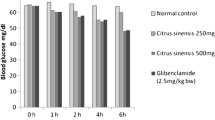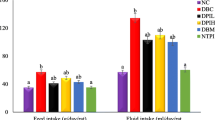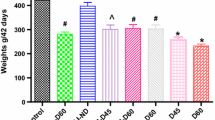Abstract
Phloridzin is the specific and competitive inhibition of sodium/glucose cotransporters in the intestine (SGLT1) and kidney (SGLT2). This property which could be useful in the management of postprandial hyperglycemia in diabetes and related disorders. Phloridzin is one of the dihydrochalcones typically contained in apples and in apple-derived products. The effect of phloridzin orally doses 5, 10, 20 and 40 mg/kg body weight on diabetes was tested in a streptozotocin-induced rat model of diabetes type 1. From beneficial effect of this compound is significant reduction of blood glucose levels and improve dyslipidemia in diabetic rats. As a well-known consequence of becoming diabetic, urine volume and water intake were significantly increased. Administration of phloridzin reduced urine volume and water intake in a dose-dependent manner. Phloretin decreases of food consumption, as well as a marked lowering in the weight. In conclusion, this compound could be proposed as an antihyperglycemic and antihyperlipidemic agent in diabetes and potential therapeutic in obesity.






Similar content being viewed by others
References
Song Y, Manson JE, Buring JE, Sesso HD, Liu S (2005) Associations of dietary flavonoids with risk of type 2 diabetes, and markers of insulin resistance and systemic inflammation in women: a prospective study and cross-sectional analysis. J Am Coll Nutr 24:376–384
Arts IC, Hollman PC (2005) Polyphenols and disease risk in epidemiologic studies. Am J Clin Nutr 81(Suppl 1):317S–325S
Knekt P, Jarvinen R, Reunanen A, Maatela J (1996) Flavonoid intake and coronary mortality in Finland: a cohort study. BMJ 312:478–481
Knekt P, Kumpulainen J, Jarvinen R, Rissanen H, Heliovaara M, Reunanen A, Hakulinen T, Aromaa A (2002) Flavonoid intake and risk of chronic diseases. Am J Clin Nutr 76:560–568
Russo GL (2007) Ins and outs of dietary phytochemicals in cancer chemoprevention. Biochem Pharmacol 74:533–544
Woods RK, Walters EH, Raven JM, Wolfe R, Ireland PD, Thien FC, Abramson MJ (2003) Food and nutrient intakes and asthma risk in young adults. Am J Clin Nutr 78:414–421
Linseisen J, Rohrmann S, Miller AB, Bueno-de-Mesquita HB, Buchner FL, Vineis P, Agudo A, Gram IT, Janson L, Krogh V, Overvad K, Rasmuson T, Schulz M, Pischon T, Kaaks R, Nieters A, Allen NE, Key TJ, Bingham S, Khaw KT, Amiano P, Barricarte A, Martinez C, Navarro C, Quiros R, Clavel-Chapelon F, Boutron-Ruault MC, Touvier M, Peeters PH, Berglund G, Hallmans G, Lund E, Palli D, Panico S, Tumino R, Tjonneland A, Olsen A, Trichopoulou A, Trichopoulos D, Autier P, Boffetta P, Slimani N, Riboli E (2007) Fruit and vegetable consumption and lung cancer risk: updated information from the European Prospective Investigation into Cancer and Nutrition (EPIC). Int J Cancer 121:1103–1114
Boyer J, Liu RH (2004) Apple phytochemicals and their health benefits. Nutr J 3:5
Mennen LI, Sapinho D, Ito H, Bertrais S, Galan P, Hercberg S, Scalbert A (2006) Urinary flavonoids and phenolic acids as biomarkers on intake for polyphenol-rich foods. Br J Nutr 96:191–198
Bellion P, Hofmann T, Pool-Zobel BL, Will F, Dietrich H, Knaup B, Richling E, Baum M, Eisenbrand G, Janzowski C (2008) Antioxidant effectiveness of phenolic apple juice extracts and their gut fermentation products in the human colon carcinoma cell line caco-2. J Agric Food Chem 56:6310–6317
Napolitano A, Cascone A, Graziani G, Ferracane R, Scalfi L, Di Vaio C, Ritieni A, Fogliano V (2004) Influence of variety and storage on the polyphenol composition of apple flesh. J Agric Food Chem 52:6526–6531
Wojdylo A, Oszmianski J, Laskowski P (2008) Polyphenolic compounds and antioxidant activity of new and old apple varieties. J Agric Food Chem 56:6520–6530
Lee KW, Kim YJ, Kim DO, Lee HJ, Lee CY (2003) Major phenolics in apple and their contribution to the total antioxidant capacity. J Agric Food Chem 51:6516–6520
Ehrenkranz JR, Lewis NG, Kahn CR, Roth J (2005) Phlorizin: a review. Diabetes/Metab Res Rev 21:31–38
Pajor AM, Randolph KM, Kerner SA, Smith CD (2008) Inhibitor binding in the human renal low- and high-affinity Na+/glucose cotransporters. J Pharmacol Exp Ther 324:985–991
Tyagi NK, Kumar A, Goyal P, Pandey D, Siess W, Kinne RK (2007) d-Glucose recognition and phlorizin-binding sites in human sodium/d-glucose cotransporter 1 (hSGLT1): a tryptophan scanning study. Biochemistry 46:13616–13628
Liu IM, Chang CK, Juang SW, Kou DH, Tong YC, Cheng KC, Cheng JT (2008) Role of hyperglycaemia in the pathogenesis of hypotension observed in type-1 diabetic rats. Int J Exp Pathol 89:292–300
Zhao H, Yakar S, Gavrilova O, Sun H, Zhang Y, Kim H, Setser J, Jou W, LeRoith D (2004) Phloridzin improves hyperglycemia but not hepatic insulin resistance in a transgenic mouse model of type 2 diabetes. Diabetes 53:2901–2909
Takii H, Matsumoto K, Kometani T, Okada S, Fushiki T (1997) Lowering effect of phenolic glycosides on the rise in postprandial glucose in mice. Biosci Biotechnol Biochem 61:1531–1535
Oku A, Ueta K, Arakawa K, Ishihara T, Nawano M, Kuronuma Y, Matsumoto M, Saito A, Tsujihara K, Anai M, Asano T, Kanai Y, Endou H (1999) T-1095, an inhibitor of renal Na+-glucose cotransporters, may provide a novel approach to treating diabetes. Diabetes 48:1794–1800
Verges B (2009) Lipid disorders in type 1 diabetes. Diabetes Metab 35:353–360
Gosavi A, Flaker G, Gardner D (2006) Lipid management reduces cardiovascular complications in individuals with diabetes and prediabetes. Prev Cardiol 9:102–107
Park Byung Hyun, Lee Yung, Walton Marlei, Duplomb Laurence, Roger H (2004) Demonstration of reverse fatty acid transport from rat cardiomyocytes. J Lipid Res 45:1992–1999
Marshall JJ, Lauda CM (1975) Purification and properties of phaseolamin, an inhibitor of alpha-amylase, from the kidney bean, Phaseolus vulgaris. J Biol Chem 250:8030–8037
Tormo MA, Gil-Exojo I, Romero de Tejada A, Campillo JE (2004) Hypoglycaemic and anorexigenic activities of an α-amylase inhibitor from white kidney beans (Phaseolus vulgaris) in Wistar rats. Br J Nutr 92:785–790
Deeg R, Ziegenhorn J (1983) Kinetic enzymic method for automated determination of total cholesterol in serum. Clin Chem 29:1798–1802
Cole TG, Klotzsch SG, McNamara J (1997) Measurement of triglyceride concentration. In: Rifai N, Warnick GR, Dominiczack MH (eds) Handbook of lipoprotein testing. AACC Press, Washington, pp 115–126
Wiebe DA, Warnick GR (1997) Measurement of high-density lipoprotein cholesterol. In: Rifai N, Warnick GR, Dominiczack MH (eds) Handbook of lipoprotein testing. AACC Press, Washington, pp 127–144
Bachorik PS (1997) Measurement of low-density lipoprotein cholesterol. In: Rifai N, Warnick GR, Dominiczack MH (eds) Handbook of lipoprotein testing. AACC Press, Washington, pp 145–160
Friedewald WT, Levy RI, Fredrickson DS (1972) Estimation of the concentration of low-density lipoprotein cholesterol in plasma, without use of the preparative ultracentrifuge. Clin Chem 18:499–502
Navas PB (2009) Chemical composition of the virgin oil obtained by mechanical pressing form several grape seed varieties (Vitis vinifera L.) with emphasis on minor constituents. Arch Latinoam Nutr 59:214–219 (in Spanish)
Tangolar SG, Ozogul Y, Tangolar S, Torun A (2007) Evaluation of fatty acid profiles and mineral content of grape seed oil of some grape genotypes. Int J Food Sci Nutr 60:1–8
Alberton EH, Damazio RG, Cazarolli LH, Chiaradia LD, Leal PC, Nunes RJ, Yunes RA, Silva FR (2008) Influence of chalcone analogues on serum glucose levels in hyperglycemic rats. Chem Biol Interact 171:355–362
Najafian M, Ebrahim-Habibi A, Hezareh N, Yaghmaei P, Parivar K, Larijani B (2010) Trans-chalcone: a novel small molecule inhibitor of mammalian alpha-amylase. Mol Biol Rep. doi:10.1007/s11033-010-0271-3
Lo Piparo E, Scheib H, Frei N, Williamson G, Grigorov M, Chou CJ (2008) Flavonoids for controlling starch digestion: structural requirements for inhibiting human α-amylase. J Med Chem 51:3555–3561
Beisswenger P, Heine RJ, Leiter LA, Moses A, Tuomilehto J (2004) Prandial glucose regulation in the glucose triad: emerging evidence and insights. Endocrine 25:195–202
Chiasson JL, Josse RG, Gomis R, Hanefeld M, Karasik A, Laakso M (2004) Acarbose for the prevention of type 2 diabetes, hypertension and cardiovascular disease in subjects with impaired glucose tolerance: facts and interpretations concerning the critical analysis of the STOP-NIDDM Trial data. Diabetologia 47:969–975
Yamagishi S, Nakamura K, Takeuchi M (2005) Inhibition of postprandial hyperglycemia by acarbose is a promising therapeutic strategy for the treatment of patients with the metabolic syndrome. Med Hypotheses 65:152–154
Rosak C, Mertes G (2009) Effects of acarbose on proinsulin and insulin secretion and their potential significance for the intermediary metabolism and cardiovascular system. Curr Diabetes Rev 5:157–164
Casaschi A, Maiyoh GK, Rubio BK, Li RW, Adeli K, Theriault AG (2004) The chalcone xanthohumol inhibits triglyceride and apolipoprotein B secretion in HepG2 cells. J Nutr 134:1340–1346
Ogawa H, Ohno M, Baba K (2005) Hypotensive and lipid regulatory actions of 4-hydroxyderricin, a chalcone from Angelica keiskei, in stroke-prone spontaneously hypertensive rats. Clin Exp Pharmacol Physiol 32:19–23
Author information
Authors and Affiliations
Corresponding author
Rights and permissions
About this article
Cite this article
Najafian, M., Jahromi, M.Z., Nowroznejhad, M.J. et al. Phloridzin reduces blood glucose levels and improves lipids metabolism in streptozotocin-induced diabetic rats. Mol Biol Rep 39, 5299–5306 (2012). https://doi.org/10.1007/s11033-011-1328-7
Received:
Accepted:
Published:
Issue Date:
DOI: https://doi.org/10.1007/s11033-011-1328-7




